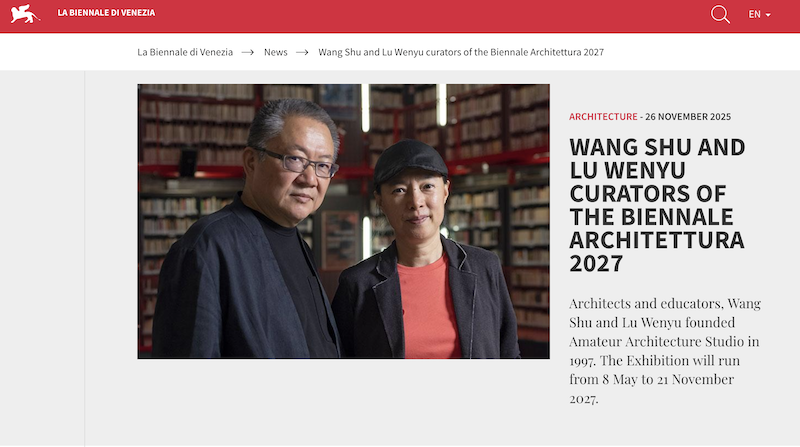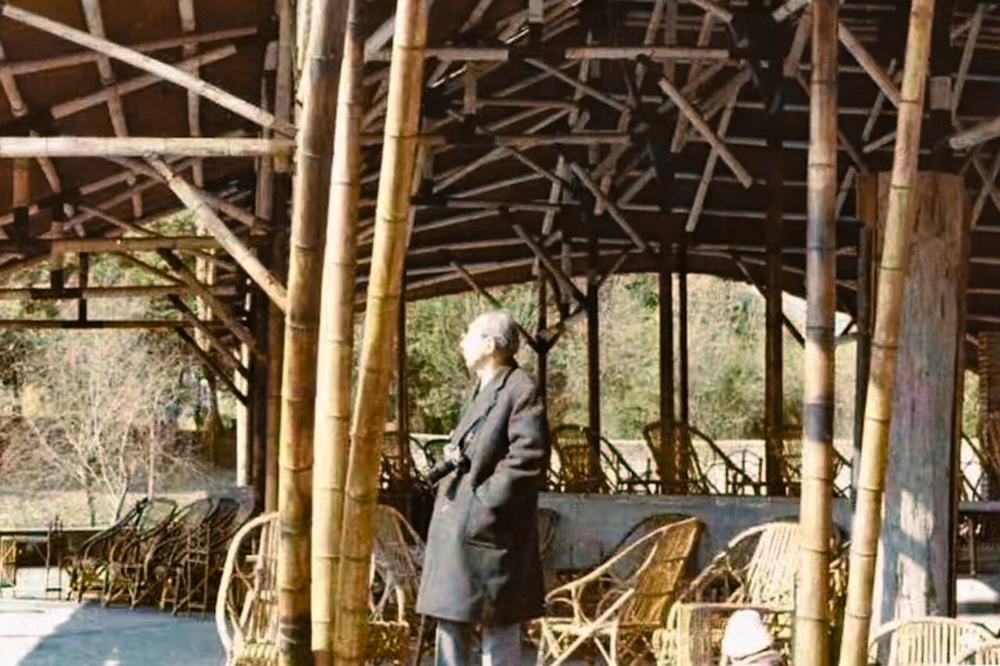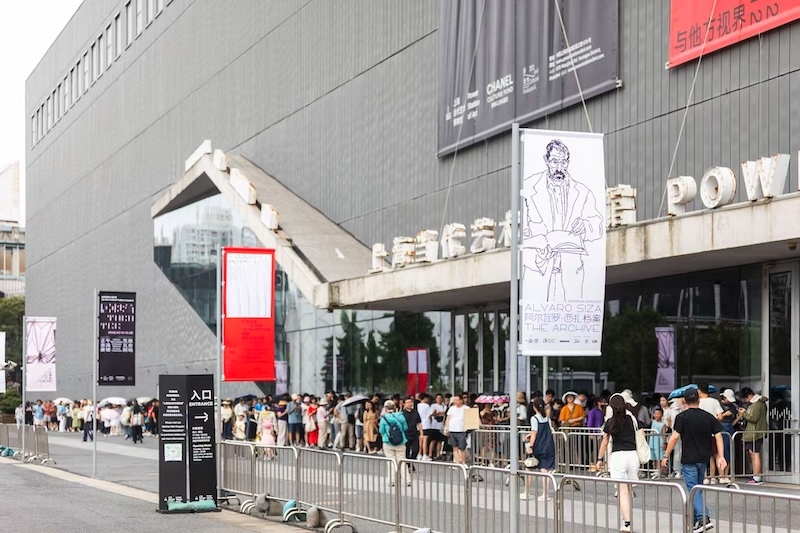
"Architecture is not about how to build, but about how to think."
The first exhibition in China of American architect Peter Eisenman (born 1932), titled "Decoding Eisenman: Beyond Form," recently opened at the China International Design Museum at the China Academy of Art, designed by Álvaro Siza. The exhibition transforms this maxim into a tangible and perceptible thought experiment. The author of this article is the curator of the "Decoding Eisenman: Beyond Form" exhibition.

At the exhibition, the China International Design Museum designed by Siza is superimposed and in dialogue with the Eisenman grid system.
Peter Eisenman is an American architect, architectural theorist, and educator. His architectural practice has gone through four independent yet intertwined phases: from exploring the symbolic system of "cardboard houses," to pioneering experiments in deconstruction and reconstruction, to the integration of interdisciplinary and digital technologies, and finally to a deep focus on local culture and context in his later years.
The exhibition revolves around three main themes, with nearly 150 precious exhibits (including original manuscripts, research models, correspondence, publications, interview recordings, and cross-disciplinary design works) forming a dynamic "slice of thought" that traces Eisenman's intellectual development, experimental design process, and the profound influence of his educational philosophy.

House I Manuscript
However, Eisenman's work has never stopped at incremental improvement; instead, it has directly attacked the core of architecture with a disruptive leap in cognition—dismantling traditional frameworks while giving birth to a completely new system of knowledge production. This exhibition decodes Eisenman's intellectual lineage from a multi-dimensional perspective—it goes far beyond the scope of a traditional architectural retrospective and is a profound academic practice that integrates philosophy, art, design, and educational thought.

Eisenman and his beloved rugby
Why bring up Eisenman again?
As one of the most controversial figures in the architectural world over the past 50 years, Eisenman's works, theoretical writings, and educational contributions have long been recorded in history, making him a veritable "living fossil of architecture." In 2004, the jury of the Golden Lion Award at the 9th Venice Biennale praised him as: "Eisenman is a thinker, educator, conceptual pioneer, highly creative architect, a master of design for the new century, and a guiding light in the field of global architectural avant-garde." Eisenman integrates interdisciplinary thinking from philosophy, linguistics, mathematics, and art into his architecture, and his multiple identities as an architect, theorist, and teacher have shrouded him in an aura of mystery.

Group photo celebrating Philip Johnson's 90th birthday
As early as the 1960s, Eisenman founded the Institute for Architecture and Urban Studies and published the magazine *Opposition*, driving radical changes in the 1970s. His work not only became a reference point for American architectural culture but also sparked theoretical debates about architecture and its internationalization. In the 1970s, Eisenman was already well-known for the white-themed architecture of the "New York Five." While Graves and others were dedicated to the symbolic narratives of postmodernism, he had already turned to philosophical inquiry into form itself and its generative logic. In 1988, Eisenman caused a sensation in the architectural world with his "Deconstructing the Seven" exhibition at the Museum of Modern Art (MoMA), using Derrida's philosophy to establish questioning, deconstruction, and reshaping as the core essence of architectural standards, thus initiating a revolution in the architectural community at the time.

Derrida's letters to Eisenman
Eisenman has long been deeply involved in architectural education laboratories. Unlike most architects, he doesn't offer specific techniques or focus on the surface of material things; instead, he studies the deeper logic that drives thought through abstraction. He is like the "Socrates" of architecture, a thinker who consistently questions the essence of architecture with a critical attitude. He forced architecture to shift from a skill for solving practical problems to a philosophical speculation about the very foundations of its existence. Through powerful theoretical construction, he has fundamentally changed the landscape of contemporary architecture.

Model of the House of Castelli
The 1980s and 90s were a vibrant period for Eisenman's academic thought. Following China's reform and opening up, a large number of Chinese scholars and architects were influenced by him, demonstrating innovative transformations of local traditions through practice, greatly propelling the development of contemporary Chinese architecture. Looking back over the past two decades, rapid urbanization has propelled Chinese architectural design and education on a relentless high-speed train, gradually deviating from its proper cultural stability and intellectual depth amidst the clamor of the market and the layers of commercial logic. Now, at a crucial juncture in China's development, how should we approach the next decade?
As architect Zhang Yonghe said, "What Eisenman did was to affirm the necessity of a pure architecture—one that is based on theory and verified by practice. This purity is precisely what is most lacking in current architectural education."
Revisiting Eisenman is timely.

Max Reinhardt House Concept Model
Exhibition as a Methodology: The Visual Translation of the Genealogy of Academic Thought
In this exhibition, we made a bold attempt: not to make the exhibition a beautiful showcase of Eisenman's works, but to make it a laboratory for putting his ideas into practice. This curatorial work is like a long puzzle-solving process: not only showing "what architecture is", but also conveying "how architecture can be thought about".
Therefore, this is an unconventional architecture exhibition—Eisenman’s work may begin with a visual challenge, but the curators hope that the audience can see beyond the surface to the rigorous logic and philosophical depth behind it.

Vickersner Art Center Concept Model
Eisenman has few completed works, and this exhibition primarily showcases his unfinished projects. However, it's important to note that Eisenman's "unfinished" works are far from mere theoretical constructs—his projects are entirely different from "architecture on paper," instead demonstrating the feasibility of his theories through practice: those drawings and axonometric plans, though unbuilt, possess the potential to be implemented at any time, thus possessing greater research value. As Cynthia Davidson states in the exhibition's foreword: "These unfinished projects are often his most radical propositions—fertile ground for reimagining the existence of architecture. They are provocative, guiding us to consider how absence, potential, and incompleteness affect the discipline of architecture."

Guardiola architectural model
"Form" is the "key" to unlocking the code of Eisenman's thought. In Eisenman's view, "form is at the top of the hierarchy of all elements," and he devoted his life to its study, which led to a series of experiments generated by form. Before the widespread use of digital tools, Eisenman attempted to liberate architecture from the traditional constraints of function, context, and meaning, pursuing "autonomy" based on the internal logic of the discipline. He drew on Chomsky's linguistic theory, treating architectural elements as "vocabulary," combining, displacing, and transforming them through pre-set "generative grammar" (transformation rules), making form the visual result of its logical operation. "Form" has far exceeded its ontological meaning.

House II Sketch
From the 1960s to the 2010s, Eisenman's thought and practice underwent four leaps, moving beyond superficial formal experiments to deeply dissecting the cognitive interface of architectural knowledge production. Through his meticulously deductive process drawings, a neglected intellectual thread becomes clearly discernible: the essence of his work, in the pre-digital age, is writing the "source code" of architecture itself through pure theory and manual labor. His practice foreshadows a fundamental shift in architecture from "shaping form" to "designing process," providing crucial historical coordinates and a theoretical framework for understanding the "formal hand" behind AI creation and generative art.

At the exhibition, the methodology of using "diagrams" as a generative tool, along with the Eisenman Project chronology, unfolds a visual knowledge grid that transcends time and space.
The exhibition interprets Eisenman's academic thought from multiple perspectives, simplifying obscure theories and reducing lengthy texts, using visual images and concise information retrieval icons to aid understanding. Employing information design, the exhibition dissects the multiple dimensions of Eisenman's architecture and its era, unfolding a visual knowledge grid spanning time and space, creating seven large-scale diagrams. Using "diagramming" as a methodological tool, the exhibition reorganizes archival documents to trace Eisenman's theoretical thought processes—"metaphysical/subjective and formal/external"—and synthesizes them into a relational map with "Outward Index: Cultural Model" and "Inward Index: Project Chronology" as its catalogues.

Eisenman's architectural language is applied across disciplines, drawing inspiration from the relationship between "solid and void" in architectural projects to create various designs.
The exhibition showcases Eisenman's cross-disciplinary application of architectural language. As he himself stated, "For architects, it is crucial to undertake projects that expand architecture and thinking to materials, space, and time. It's like abstract painting—the challenge lies in perceiving a sense of space with multiple layers within a single depth, which is what I call 'architectural abstraction.'" The rings, bracelets, and other jewelry, as well as carpets and various patterned fabrics on display, are cross-disciplinary designs inspired by the relationship between "solidity and emptiness" in his architectural projects. These cross-disciplinary works are by no means derivative products of a lower dimension, but rather experimental translations of his architectural critical language: implanting spatial symbols into the most exquisite surface of consumer society.

Carpet patterns
The exhibition also showcases an expanded educational dimension. The course "Deconstruction and Construction" from the School of Sculpture and Public Art at the China Academy of Art, based on an understanding of Eisenman, resulted in works by these young students. These installations not only transcend the limitations of architecture, echoing the shared origins of Eisenman's thought and conceptual art, but also serve as an "artistic portrayal" of the formation of his conceptual architecture. After Eisenman's own commentary, these students' contemporary interpretations are juxtaposed with his early design models, reflecting the expectations of the nonagenarian for his young students. These juxtaposed works, though separated by half a century, share the same spirit of exploration. This inheritance of spirit is perhaps more important than any specific form.

Based on their understanding of Eisenman, young art students created a course project titled "Deconstruction and Construction."
Inspiration: Constructing the future of Chinese architecture beyond form
The exhibition practice of "Decoding Eisenman: Beyond Form" is both an inquiry into the essence of architecture and a mirror reflecting the development of education and disciplines in China.
Eisenman's life's work was a deep exploration of the core of his discipline and a courageous questioning of established paradigms. This undoubtedly offers profound insights for Chinese education, which is currently undergoing transformation and restructuring. Under the long-standing inertia of prioritizing pragmatism and skills transmission, China's current education system often neglects the cultivation of fundamental critical thinking and theoretical construction abilities.

Letters to Adolphus regarding House III
Eisenman's practice is a demonstration of "slow thinking"—he refuses to drift along with the noisy appearances, but instead immerses himself in the core of the discipline, engaging in rigorous self-examination and paradigm revolution. This also indicates that Chinese education and academic research urgently need to cultivate this "courage to immerse oneself" and "patience to create," daring to engage in preliminary philosophical speculation in order to generate original theoretical discourse.

House VI Manuscript

houseVI series models
This curatorial work is not only a critical exhibition practice using Eisenman's ideas, but also a vivid demonstration of an interdisciplinary educational approach. Through the collaborative "decoding" of visual communication, information design, art, and technology, Eisenman's obscure theories are translated into a tangible and knowable three-dimensional narrative.
This also proves that interdisciplinary studies are not simply a patchwork of knowledge, but rather a collision of different methodologies and perspectives that gives rise to entirely new paradigms for understanding complex problems, providing indispensable thinking tools for addressing future comprehensive challenges. Future creativity will increasingly rely on building a strong intellectual foundation "beyond form."

IAUS logo
Eisenman's practice and theory inspire us that to build a distinctive and influential "Chinese model," we should be based on Chinese wisdom and cultural traditions, transcend mere formal imitation and utilitarian drive, and refine a universal architectural philosophy within the context of Chinese reality, thereby elevating it into an architectural theoretical discourse that belongs to China itself.
Perhaps this is the precious legacy that this exhibition leaves for the Chinese academic community: thought is the highest form, and the ultimate mission of education is to ignite and safeguard the inextinguishable light of reason.
This article and exhibition are dedicated to Peter Eisenman.

The EL-type experiment marks a significant turning point in the study of Eisenman's ideas; the spatial arrangement of the exhibits creates mutual perspectives, suggesting connections between the projects.
(The author is the curator of the exhibition "Decoding Eisenman: Beyond Form" and an associate professor at the China Academy of Art. The original title of this article was "On the Edge of Thought: Eisenman's Reflections on Chinese Architecture and Education." This exhibition will run until December 30.)


